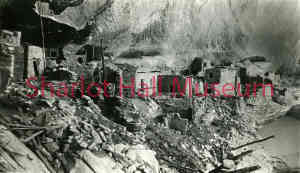Keet Seel Cliff Dwelling
details
Unknown Unknown 1508-1467-0003.jpg IN-PR-1467 B&W 1508-1467-0003 1508-1467-0003 Print 4x6 Historic Photographs 1940s Reproduction requires permission. Digital images property of SHM Library & ArchivesDescription
Keet Seel or Kiet Siel (Kįtsʼiil), which stands for "broken pottery scattered around" in Navajo, is a well preserved cliff dwelling of the ancient Ancestral Pueblo people located in a branch of the Tsegi Canyon in the Kayenta region. The site was first occupied at around 1250, during a time in which a large number of people were believed to be aggregating in sites such as this in this part of the American Southwest. There was a construction boom at Keet Seel between 1272 and 1275, with construction then slowly tapering off and halting completely at 1286. Once construction halted in 1286, there was no evidence of structures being built until its subsequent abandonment some 20 years later.
It is believed that, at its peak, up to 150 people inhabited this site at one time. Due to the extremely dry climate and natural overhanging cliff the site's dwellings and artifacts are well preserved. Keet Seel is considered by many archaeological experts to be one of the best preserved larger ruins in the American Southwest.
Archaeologists have determined that there was a distinct decrease in the amount of annual precipitation between AD 1276 and 1299, a period of time that is now referred to as the "Great Drought". With the limited amount of rainfall in an already arid environment, there is no doubt that there was a considerable amount of increased stress put on the agricultural systems that these people depended on.
Near the end of the thirteenth century it's evident that the Ancestral Pueblo people migrated towards places with more stable and abundant water sources, suggesting that the agricultural land in this area had become unsuitable to sustain the population levels that once inhabited this spectacular cave site.
Hopi legends tell a different tale. According to oral tradition, the area known as Wunuqa (modern day Tsegi Canyon) was abandoned as part of a spiritual quest. In particular, the Snake Clan inhabited the Navajo National Monument ruins, along with the Horn Clan. The Horn Clan forced the Snake Clan out, due to the children of the Snake Clan biting other children and causing death. This may be an allegory for some historical occurrence, in which one group forced another out for a perceived fault or slight.
Purchase
To purchase this image please click on the NOTIFY US button and we will contact you with details
The process for online purchase of usage rights to this digital image is under development. To order this image, CLICK HERE to send an email request for details. Refer to the ‘Usage Terms & Conditions’ page for specific information. A signed “Permission for Use” contract must be completed and returned. Written permission from Sharlot Hall Museum is required to publish, display, or reproduce in any form whatsoever, including all types of electronic media including, but not limited to online sources, websites, Facebook Twitter, or eBooks. Digital files of images, text, sound or audio/visual recordings, or moving images remain the property of Sharlot Hall Museum, and may not be copied, modified, redistributed, resold nor deposited with another institution. Sharlot Hall Museum reserves the right to refuse reproduction of any of its materials, and to impose such conditions as it may deem appropriate. For certain scenarios, the price for personal usage of the digital content is minimal; CLICK HERE to download the specific form for personal usage. For additional information, contact the Museum Library & Archives at 928-445-3122 ext. 14 or email: orderdesk@sharlot.org.




